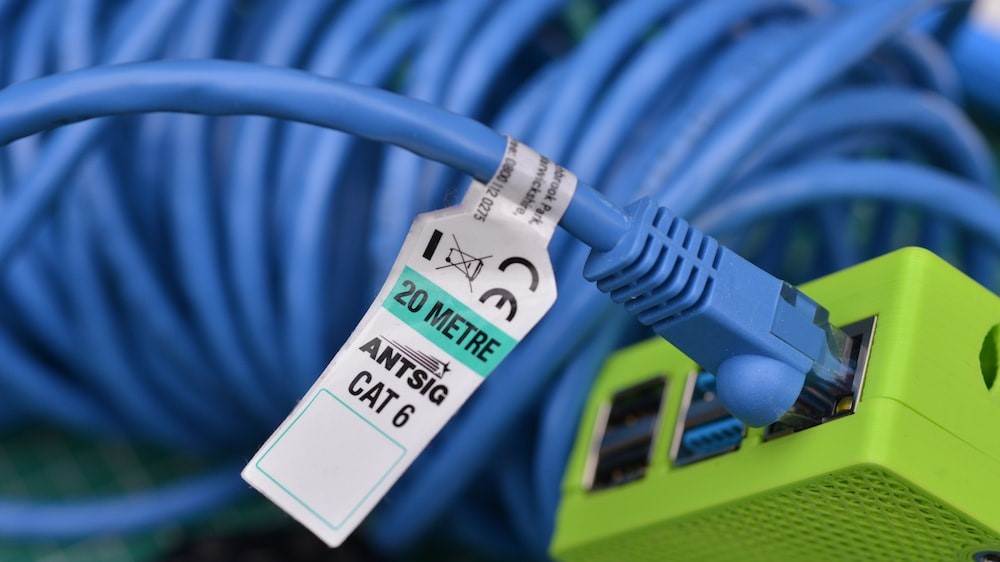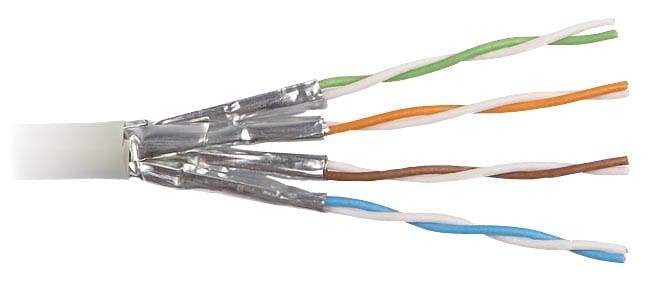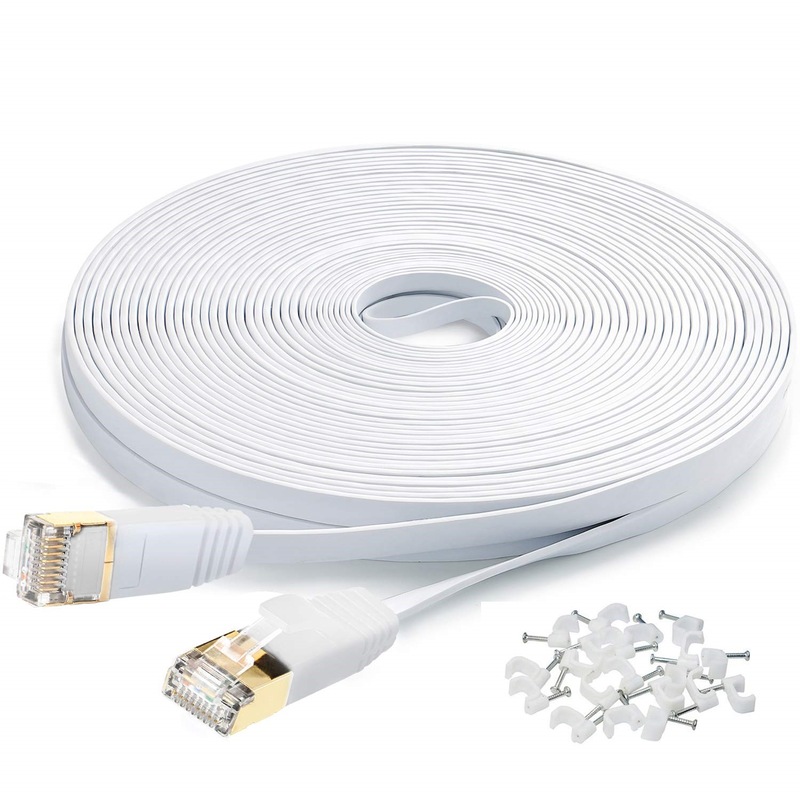Even though Wi-Fi offers incredible throughput and increased reliability, Ethernet remains the more reliable option when setting up a network. It is also important that Ethernet connections are more capable. Granted, you should have the best Ethernet infrastructure, especially Ethernet cables.
To achieve these maximum capabilities, you should understand the different types of Ethernet cables and how these differences translate to performance and speed. This guide will take you through many Ethernet cable categories.
Different Types of Ethernet Cables You Can Choose From
You can choose between different categories of Ethernet cables, such as Cat6 and Cat8, depending on your speed requirements. It is also good to pay attention to the shielding options on the cable, while also choosing a suitable Ethernet cable style for your purpose.
An Introduction to Ethernet
I believe you must have a brief introduction to Ethernet before going through the different types of Ethernet cables. Do not worry, I will try to be as lucid as possible while explaining these ideas.

At its core, Ethernet is a combination of technologies that helps you create a LAN. A Local Area Network is a group of interconnected devices that can exchange information. Even though you can use Ethernet to create MAN (Metropolitan Area Networks) and WAN (Wide Area Networks), the basic connotation is that you use Ethernet technology for a LAN.
Compared to other technologies for networking, Ethernet offers numerous advantages. Many of these pros matter when I want to create a LAN for my home or a small office. For instance,
- Depending on the infrastructure choices, Ethernet connections can be as fast as 100Gbps. This alone makes Ethernet a great solution for high-speed data transfer within the network.
- As I said earlier, reliability is a big reason why Ethernet is the best option. Once set up, Ethernet can work flawlessly, requiring minimal to zero maintenance for years.
- Network management over Ethernet is relatively simpler and well-documented. You can leverage its popularity while seeking community support.
- Ultimately, Ethernet is also the most compatible and cost-effective option for networking. You would easily find Ethernet ports on various devices, ranging from PCs to consoles.
If these advantages appeal to you, you should consider Ethernet for setting up a network for your home or office space. Now, the ultimate performance from your Ethernet network relies on a few things.
- Devices in the network
- Ethernet cables
- Internet connection speed
The third option applies only when you need internet access through Ethernet. It also means that you might need a local Ethernet system for data transfer between connected devices. In that case, you have to ensure that the devices have a compatible Ethernet port and that you get a powerful Ethernet cable.
Different Types of Ethernet Cables: Categories for Speed/Performance
First, we will take a look at the different types of Ethernet cables based on the categories decided for speed and performance. So, regardless of all the variables like style and design, these categories will help you understand the transmission speed capabilities of the Ethernet cable.
Cat1 to Cat5 Ethernet Cables
Though they were popular in the early years of networking, Cat1, Cat2, Cat3, Cat4, and Cat5 Ethernet cables are out of the picture now. They were designed to fulfil the networking requirements of an older period. For instance, Cat5 cables were introduced in 2001 and had a maximum speed of 100Mbps.
So, unless you are looking for something very specific, I would not recommend going for Cat5 Ethernet cable models. I would also assume that most internet connections offer more than a 100Mbps speed. Hence, even for internet access, Cat5 Ethernet cables would not cut it.
Cat5e Ethernet Cables
Cat5e Ethernet cables solved the multiple limitations that Cat5 cables faced, including interference and low transmission speeds. For reference, Cat5e cables offer a maximum transmission speed of 1000Mbps/1Gbps at a distance of 100 meters.
So, if you have devices with a Gigabit Ethernet port, you can use Cat5e cables for the network. You can expect impressive data transfer speeds and a smooth internet experience, subject to the resources from the ISP. It also makes Cat5e the best affordable Ethernet cable in the market.
Cat6 Ethernet Cables
Cat6 cables take things higher in terms of bandwidth and transmission speeds. To complement this added power, these cables also come with braided shielding capable of reducing crosstalk (interference). As you can guess, Cat6 cables are more expensive than Cat5 and Cat5e cables.

In terms of speed, Cat6 cables have a maximum transmission speed limit of 10Gbps when the distance is less than 37 meters. However, if your network spans longer, the speeds may drop to 1Gbps. If you want to get such speeds on your network, Cat6 Ethernet cables are the way to go.
Cat6a Ethernet Cables
Cat6a Ethernet cables are an augmented version of Cat6 Ethernet cables. This improvised variant supports a higher bandwidth and transmission speeds. For instance, you can get a maximum speed of 10Gbps at a distance of 100 meters.
Cat6a Ethernet cables are, thus, a great option for office network situations.
Cat7 and Cat7a Ethernet Cables
Cat7 and Cat7a Ethernet cables definitely offer better performance than previous standards, but they come with a serious limitation. For instance, these cables offer a maximum transmission speed of 100Gbps at a 15-meter distance. But the problem is with the connector.
These cables use a proprietary connector, called GigaGate45. While this connector is backward-compatible with RJ45 connectors, it does not offer the best speeds. And, due to its proprietary nature, many product manufacturers did not adopt the standard.
As a result, you cannot find extended compatibility for Cat7 or Cat7a Ethernet cables. Therefore, if I would not recommend these cables to anyone. If you are concerned about speed limits, you are better off with Cat6 or Cat6a cables. On the other hand, if you want to future-proof everything, you should go with Cat8.
Cat8 Ethernet Cables
It all brings us to Cat8 Ethernet cables, which is the latest standard for networking. You can go for this cable if you want all the benefits of speed, performance, and reliability.
For reference, Cat8 Ethernet cables can provide a maximum speed of 40Gbps at a distance of 30 meters. As these cables operate at a maximum frequency of 2000MHz, they come with extra shielding, thus reducing signal interference by a long shot.

As you can guess, since Cat8 Ethernet cables are the optimal standard, they can be expensive. But, on the bright side, you do not have to worry about compatibility for years. In theory, these cables are suited for data-center-like speeds. So, as long as you have the right ports, you get the best networking experience.
Different Types of Ethernet Cables: Shielding and Wrapping
Now, we will look at another aspect of Ethernet cables, dealing with protecting the cables from interference and other physical hindrances.
Unshielded Twisted Pair, called UTP
It offers the basic level of protection from electromagnetic interference and physical issues. This type of Ethernet cable uses a pair of wires that are twisted together, and you don’t get many fielding protection options. There is only a level of plastic coating that protects the wires. These cables are becoming very uncommon in the industry because they are not suited for high-performance purposes.
Foiled Twisted Pair, called FTP
You should go for FTP Ethernet cables if you are looking for an additional layer of shielding, which is called screening in many cases. So, in addition to twisted individual wires, these Ethernet cables will have a metallic shielding option. So, you get better protection from electromagnetic interference. And even when you have high voltage devices in the vicinity, you don’t have to worry about speed concerns.
Shielded Twisted Pair, called STP
STP Ethernet cables are the best option out there when you need the best performance and protection from all these interference issues. The maximum amount of protection from these cables makes them a suitable option for data senders where the cables need to go under different circumstances. Of course, you will have to pay a little more for these cables, but they protect the system from many issues.

As we said earlier, many of these shielding capabilities are built into the category of Ethernet cables. For instance, Cat8 cables can expect the speed only if they come with shielded capabilities. Therefore, it is difficult for you to find a Cat8 Ethernet cable without shielding properties. It is in one way great because you don’t have to worry about additional configuration while getting an Ethernet cable.
Different Types of Ethernet Cables: Styles
In addition to the performance and protection, you can also purchase Ethernet cables with different styles. These different Ethernet cables are designed for and more optimized for specific purposes. We will take a brief look at these cables and recommend which one is great for which purposes.
Slim and Ultra-slim Ethernet Cables
Compared to the conventional Ethernet cables, slim and ultra slim Ethernet cables are designed for a lower profile. So if you are worried about airflow concerns within the network, you might want to go for the slim options. Even though they compromise a little on the shielding department, you can get the best out of it in terms of cooling.
Solid-core Ethernet Cables
Then again, compared to conventional Ethernet cables, solid-core Ethernet cables will be using solid copper wires instead of copper that is wrapped with aluminum. As a result, these cables offer improved performance when you want better distances between devices. The signal preservation capabilities are also great, and you don’t have to worry about physical hindrances.
Flat Ethernet Cables
Are you looking for a type of Ethernet cable that can be hidden under something like a carpet? In that case, you would want to go for flat Ethernet cables. They do not compromise in terms of performance, but the design is optimized to go with modern systems.

Armored Ethernet Cables
You can go for armored Ethernet cables if you are looking for different layers of additional protection. These are great if you want the Ethernet cable to go outside and spaces where corrosion and physical damage are an issue. You will definitely have to pay more for these cables because of the additional shielding capabilities.
Braided Ethernet Cables
Braided Ethernet cables are also a great option when you need a flexible set of infrastructure for your network. For instance, these braided cables can withstand a lot of flexibility practices, that is, if you want to bend the cable more often than you would in an ideal network, I would definitely recommend going for braided Ethernet cables.

Which Is the Best Ethernet Cable?
As much as I want to, I cannot say that one type of Ethernet cable is the best for all purposes. At the end of the day, you have to consider multiple factors in deciding which cable works best for you. But of course, I can give you some pointers. You can answer these questions and understand which would be suited for you.
Speed Concerns
If you are looking for the maximum transmission speed within a network, you should go for Cat 8 Ethernet Cables. These cables come with additional shielding that also protect them from signal interference and common issues. But the biggest part is that you are future proofing your network for what is to come.
So even if you upgrade your internet connection to something huge or want to transfer a huge chunk of information via Ethernet, a Cat8 Ethernet Cable will keep you sorted for at least a few years, and you don’t have to worry about infrastructure level upgrades at this time.
On the other hand, if you want to keep the costs to a minimum while still getting decent transmission speeds, you should go for Cat6 or Cat6a Ethernet cables. These are powered with better bandwidth and transmission speeds, and they don’t cost a lot. At the same time, if you foresee an upgrade in the near future, you should be ready to upgrade.
Additional Protection
I truly believe you should also consider the nature of the network in terms of physicality. That is, do you plan to use the Ethernet cables in an environment where physical hindrances are an issue? In that case, you will have to pay extra for additional protection for these cables. And you can easily find them in the market as long as you are willing to pay.
You might also want to consider different types of cables that make use of fiber optics if you are looking for maximum flexibility and speed, but then they are not necessary when you plan a home network.
Device Compatibility
Here is something most people forget while choosing an Ethernet cable. Regardless of the quality and transmission speeds of the Ethernet cable that you choose, the ultimate experience depends on whether you have compatible devices.
That is, if you are going for a Gigabit level network, your devices should have gigabit level Ethernet ports in the first place. Otherwise, they will not be able to make use of the additional speed or performance for that matter.
In the same way, you should also ensure that the Internet connection has such bandwidth if you are looking for high-speed downloads or very frequent transactions.
I believe I have answered the core questions you may come across while choosing an Ethernet cable for your purposes.
How I Chose the Best Ethernet Cable for My Home Office
Before we conclude, I would like to share my experience of setting up my home office network, which consists of around 5 computers and a number of other Ethernet enabled devices. I am also using some network attached storage devices for easy data transfer within the systems. Because I work on video, I also wanted to make sure that these computers can edit the video from the network.
Here are a few things that I noted.
Foremost, because future proofing and speed limits were of primary importance, I wanted to go for CAT 8 Ethernet cables. I don’t regret this decision because I believe the money I spent on these cables are definitely worth the performance that I get.
I also wanted to go for additional protection for these cables because I also thought this investment would be worth the resources that I get. Going in line with those assumptions, the performance from these devices has been great.
I would much recommend it to anyone who is looking for a future proofed network for their home or office.
Frequently Asked Questions
As per the current standards, CAT 8 Ethernet cables are the fastest option you can get from the market. These cables are designed to offer speeds up to 40Gbps and work at a standard bandwidth of 2000MHz. Because these cables also come with shielding, you don’t have to worry about physical hindrances.
The differences between Cat5 and Cat6 cables mostly have to do with the bandwidth at which they operate. For reference, Cat5 cables operate at a bandwidth of 100 MHz and the maximum data rate is only 100 Mbps. On the other hand, Cat6 Ethernet cables have an enhanced bandwidth of 250MHz, and they offer speeds up to 1Gbps. Then again, you can go with additional shielding options with both options.
Cat 8 Ethernet cables are definitely worth the extra money that you have to spend on them. In addition to offering the maximum data rate, Cat8 Ethernet cables also offer additional shielding and future-proofing. So, you can stay worry-free of compatibility even during potential infrastructure upgrades.
Conclusion
I have tried to explain the differences between Ethernet cables and the different types of Ethernet cables without going too much into the technicalities. And I have referred to different use case scenarios and personal insights so that you would have an easy time choosing the right option for your networking needs.